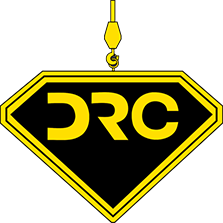Cranes are powerful machines that can be dangerous. It’s important to follow safety rules. This guide helps crane operators, site managers, and safety officers understand the safety equipment needed.
We will talk about the important safety equipment, including Personal Protective Equipment (PPE), advanced safety devices, and support systems. Each part explains why these are important, how to use them, and how to take care of them. This helps prevent accidents and keeps the work environment safe.
Personal Protective Equipment (PPE)
PPE is the first line of defense against workplace dangers. It protects workers from risks like falling objects, electrical shocks, and visibility problems. Using PPE correctly helps prevent injuries and ensures everyone goes home safely.
Types of PPE Used in Crane Operations
1. Hard Hats
These protect against head injuries from falling or fixed objects. Choose hard hats that meet standards like ANSI or ISEA and check them regularly for damage.
2. Safety Glasses or Goggles
These protect eyes from flying debris, dust, and chemical splashes. Make sure they are ANSI-approved and fit well without blocking vision.
3. High-Visibility Clothing
This ensures crane operators and ground workers are visible, especially in low light or when large loads block the view.
4. Steel-Toed Boots
These protect feet from falling objects and sharp debris, providing stability and slip resistance.
Proper Usage of PPE
Using PPE correctly is crucial. This means choosing the right size, knowing how to wear it properly, and not altering or removing any protective parts. Regular training helps workers use PPE correctly and think about safety first.
Maintenance and Care of PPE
PPE must be in good condition to work well. Inspect it daily and replace damaged items immediately. Clean and store PPE properly to extend its life. Both employers and employees are responsible for maintaining PPE.
Crane Operational Safety Devices
Crane safety devices are crucial for smooth and safe operations. They monitor crane activities, prevent accidents, and ensure compliance with safety standards.
Key Safety Devices
1. Load Indicators
These show the weight of the load being lifted, helping operators avoid overloading.
2. Anti-Collision Systems
These use sensors to detect and prevent collisions between cranes.
3. Limit Switches
These stop cranes from exceeding safe operational limits, preventing failures.
Implementation and Benefits
Installing and maintaining these devices involves proper setup, regular calibration, and training. Benefits include enhanced safety, reduced equipment damage, less downtime, and protected lives.
Maintenance and Regular Checks
Regular inspections and maintenance ensure safety devices work well. Documenting these activities is important for compliance and safety records.
Communication Equipment
Good communication is key to crane operations, ensuring all movements are coordinated and hazards are addressed promptly.
Essential Communication Tools
3. Two-Way Radios
These allow clear communication between crane operators, riggers, and spotters.
2. Signal Lights and Horns
These provide clear signals over long distances or when radios can’t be used.
Effective Communication Protocols
Investing in quality equipment is the first step. Establish clear communication protocols, train all personnel, and conduct regular drills.
Maintenance and Regular Testing
Regular checks and maintenance prevent equipment failures. Ensure batteries and backup systems are always in good condition.
Safety Harnesses and Lanyards
Fall protection equipment, like safety harnesses and lanyards, prevents serious injuries from falls.
Components and Usage
1. Safety Harnesses
These distribute fall forces across the body. Ensure a correct fit for maximum protection.
2. Lanyards
These connect the harness to a secure anchor point. Shock-absorbing lanyards reduce fall impact.
Training and Compliance
Train workers on how to wear and inspect harnesses, and select and use lanyards correctly. Regular drills ensure these practices become habits.
Maintenance and Inspection
Inspect harnesses and lanyards regularly for damage. Follow manufacturer instructions for cleaning and storage, and replace any worn parts.
Crane Inspection and Maintenance Tools
Regular inspection and maintenance keep cranes safe and working well. These tools help identify and fix issues.
Key Tools and Equipment
1. Inspection Kits
These include tools for checking wire ropes, hooks, and structural elements.
2. Maintenance Tools
Wrenches, lubrication equipment, and alignment tools are essential for routine maintenance.
Routine Checks and Maintenance Schedules
Daily inspections and following a strict maintenance schedule ensure crane safety. Address any issues found during inspections promptly.
Record Keeping and Compliance
Keep detailed records of inspections and maintenance for compliance and accountability.
Frequently Asked Questions
1. What is the most important piece of safety equipment for crane operators?
The most important piece of safety equipment for crane operators is PPE. This includes hard hats, safety glasses, high-visibility clothing, and steel-toed boots. PPE provides essential protection against common workplace hazards, helping to prevent injuries.
2. How often should crane safety equipment be inspected?
Crane safety equipment should be inspected daily before use. Regular inspections help identify any damage or wear and tear, ensuring that all equipment remains in good working condition and provides the necessary protection.
3. Why is communication equipment essential in crane operations?
Communication equipment, such as two-way radios and signal lights, is essential because it ensures clear coordination between crane operators and ground personnel. Effective communication helps prevent accidents and ensures that all movements are safely and efficiently executed.
Learn More About Safety Equipment
Understanding and using crane safety equipment is vital for a safe work environment. This guide has covered essential safety equipment and practices.
Our instructors in Baytown, Texas offer training and support to help your team operate crane equipment safely. If you have questions about our training and safety protocols, we’d love to talk with you!
Register for classes with Diamond Rigging and Crane now!





